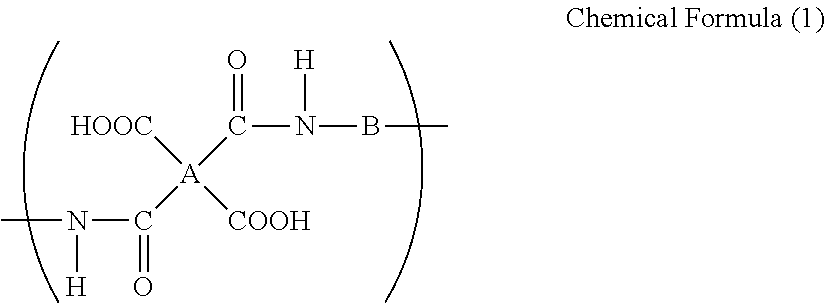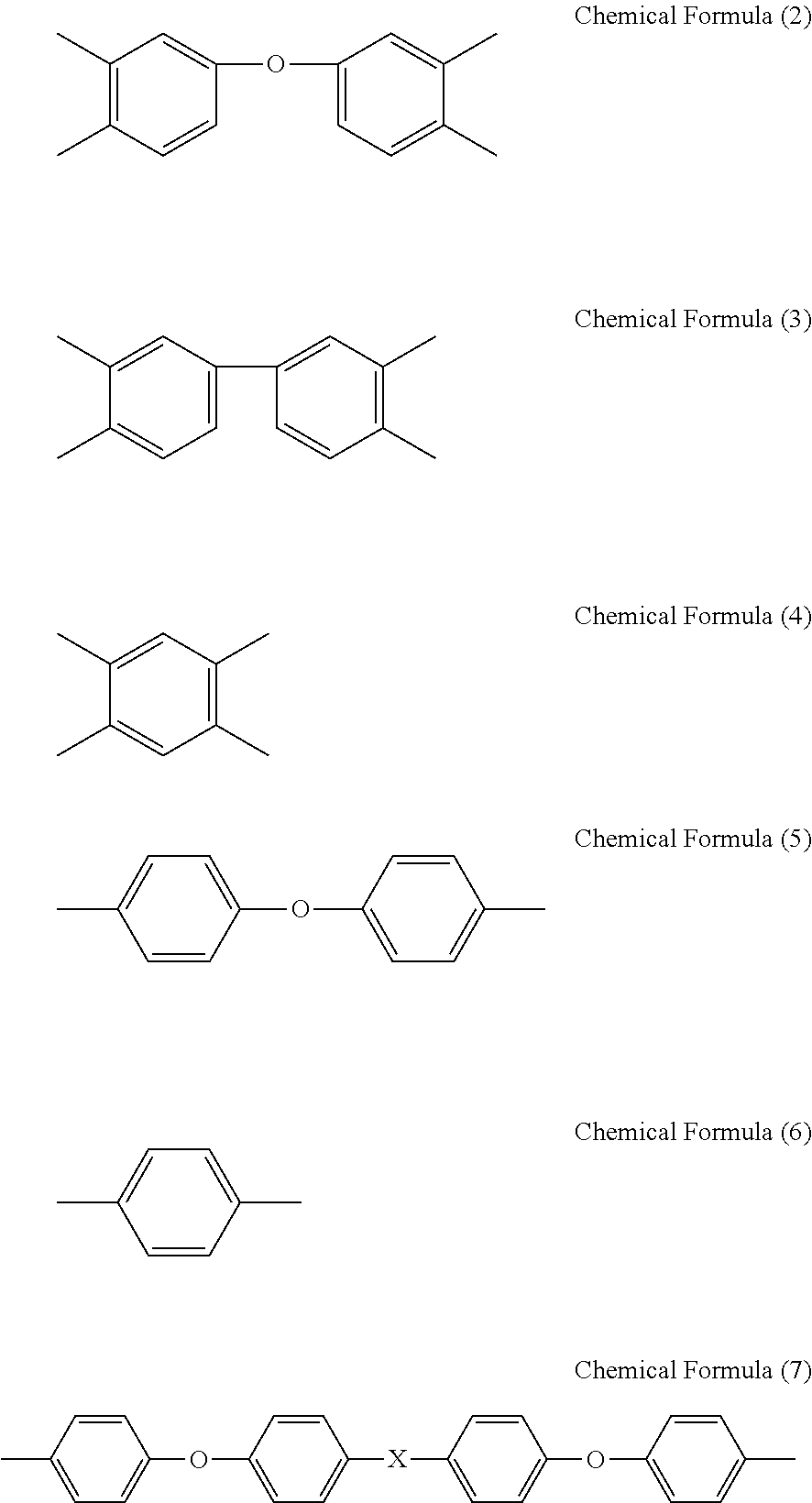Binder resin composition for electrode, electrode mixture paste, and electrode
a technology of binder resin and electrode, which is applied in the direction of non-metal conductors, cell components, conductors, etc., can solve the problems of reducing affecting the conductivity of the electrode, and causing the volume change in accordance with the active material, etc., to achieve high breaking energy, small swelling, and high breaking strength
- Summary
- Abstract
- Description
- Claims
- Application Information
AI Technical Summary
Benefits of technology
Problems solved by technology
Method used
Image
Examples
example 1
[0100]To a glass reaction vessel with internal volume of 500 mL that is equipped with a stirrer and an inlet • outlet for nitrogen gas, 400 g of NMP was added as a solvent. To the solvent, 25.85 g (0.239 mol) of PPD and 74.15 g (0.239 mol) of OPDA were added and the mixture was stirred for 10 hours at 50° C. to obtain a binder resin composition for an electrode which has a solid matter content of 18.1% by mass, solution viscosity of 4.9 Pa·s, and inherent viscosity of 0.75.
[0101]The binder resin composition for an electrode which has been obtained from the above was coated on a glass plate substrate by using a bar coater. The coated film was de-foamed and pre-dried under reduced pressure for 30 minutes at 25° C., and was then placed in a hot air dryer in nitrogen gas atmosphere under atmospheric pressure and heated for 30 minutes at 120° C., 10 minutes at 150° C., 10 minutes at 200° C., 10 minutes at 250° C., and 10 minutes at 400° C. to form a binder resin film having a thickness o...
example 2
[0104]To a glass reaction vessel with internal volume of 500 mL that is equipped with a stirrer and an inlet • outlet for nitrogen gas, 400 g of NMP was added as a solvent. To the solvent, 39.23 g (0.196 mol) of ODA and 60.77 g (0.196 mol) of OPDA were added and the mixture was stirred for 10 hours at 50° C. to obtain a binder resin composition for an electrode which has a solid matter content of 18.3% by mass, solution viscosity of 5.2 Pa·s, and inherent viscosity of 0.78.
[0105]The binder resin composition for an electrode which has been obtained from the above was coated on a glass plate substrate by using a bar coater. The coated film was de-foamed and pre-dried under reduced pressure for 30 minutes at 25° C., and was then placed in a hot air dryer in nitrogen gas atmosphere under atmospheric pressure and heated for 30 minutes at 120° C., 10 minutes at 150° C., 10 minutes at 200° C., 10 minutes at 250° C., and 10 minutes at 350° C. to form a binder resin film having a thickness o...
example 3
[0108]To a glass reaction vessel with internal volume of 500 mL that is equipped with a stirrer and an inlet • outlet for nitrogen gas, 400 g of NMP was added as a solvent. To the solvent, 56.96 g (0.139 mol) of BAPP and 43.04 g (0.139 mol) of ODPA were added and the mixture was stirred for 10 hours at 50° C. to obtain a binder resin composition for an electrode which has a solid matter content of 18.5% by mass, solution viscosity of 5.0 Pa·s, and inherent viscosity of 0.74.
[0109]The binder resin composition for an electrode which has been obtained from the above was coated on a glass plate substrate by using a bar coater. The coated film was de-foamed and pre-dried under reduced pressure for 30 minutes at 25° C., and then placed in a hot air dryer in nitrogen gas atmosphere under atmospheric pressure and heated for 30 minutes at 120° C., 10 minutes at 150° C., 10 minutes at 200° C., 10 minutes at 250° C., and 10 minutes at 350° C. to form a binder resin film having a thickness of 5...
PUM
| Property | Measurement | Unit |
|---|---|---|
| mol % | aaaaa | aaaaa |
| mol % | aaaaa | aaaaa |
| mol % | aaaaa | aaaaa |
Abstract
Description
Claims
Application Information
 Login to View More
Login to View More - R&D Engineer
- R&D Manager
- IP Professional
- Industry Leading Data Capabilities
- Powerful AI technology
- Patent DNA Extraction
Browse by: Latest US Patents, China's latest patents, Technical Efficacy Thesaurus, Application Domain, Technology Topic, Popular Technical Reports.
© 2024 PatSnap. All rights reserved.Legal|Privacy policy|Modern Slavery Act Transparency Statement|Sitemap|About US| Contact US: help@patsnap.com










